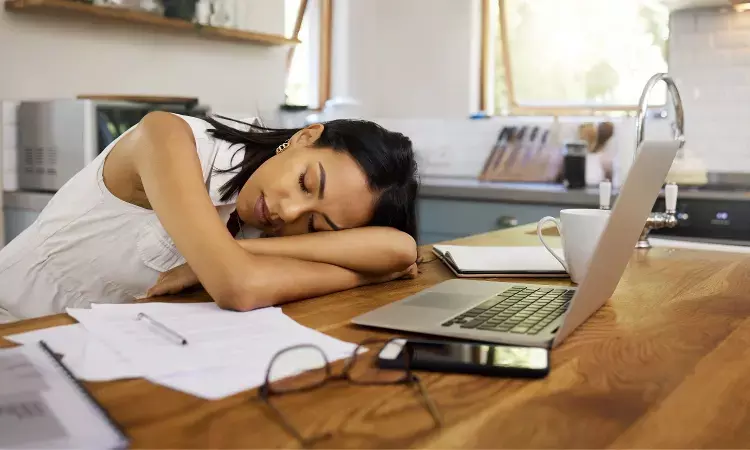- Home
- Medical news & Guidelines
- Anesthesiology
- Cardiology and CTVS
- Critical Care
- Dentistry
- Dermatology
- Diabetes and Endocrinology
- ENT
- Gastroenterology
- Medicine
- Nephrology
- Neurology
- Obstretics-Gynaecology
- Oncology
- Ophthalmology
- Orthopaedics
- Pediatrics-Neonatology
- Psychiatry
- Pulmonology
- Radiology
- Surgery
- Urology
- Laboratory Medicine
- Diet
- Nursing
- Paramedical
- Physiotherapy
- Health news
- Fact Check
- Bone Health Fact Check
- Brain Health Fact Check
- Cancer Related Fact Check
- Child Care Fact Check
- Dental and oral health fact check
- Diabetes and metabolic health fact check
- Diet and Nutrition Fact Check
- Eye and ENT Care Fact Check
- Fitness fact check
- Gut health fact check
- Heart health fact check
- Kidney health fact check
- Medical education fact check
- Men's health fact check
- Respiratory fact check
- Skin and hair care fact check
- Vaccine and Immunization fact check
- Women's health fact check
- AYUSH
- State News
- Andaman and Nicobar Islands
- Andhra Pradesh
- Arunachal Pradesh
- Assam
- Bihar
- Chandigarh
- Chattisgarh
- Dadra and Nagar Haveli
- Daman and Diu
- Delhi
- Goa
- Gujarat
- Haryana
- Himachal Pradesh
- Jammu & Kashmir
- Jharkhand
- Karnataka
- Kerala
- Ladakh
- Lakshadweep
- Madhya Pradesh
- Maharashtra
- Manipur
- Meghalaya
- Mizoram
- Nagaland
- Odisha
- Puducherry
- Punjab
- Rajasthan
- Sikkim
- Tamil Nadu
- Telangana
- Tripura
- Uttar Pradesh
- Uttrakhand
- West Bengal
- Medical Education
- Industry
Sleep position and oral appliance therapy effective for positional obstructive sleep apnea

A study published in Sleep Medicine concluded that novel eye mask sleep position therapy ( SPT ) and Oral Appliance Therapy (OAT) are effective in managing positional obstructive sleep apnea (POSA). Combo of these two is highly effective than treatment alone, thereby presenting as an excellent therapeutic option for managing POSA.
SPT and OAT have been used to treat POSA, but only some relevant clinical studies have been conducted in Chinese populations. More data must be collected on the combined effects of SPT and OAT.
Considering this background, the research explored whether a new eye mask SPT and OAT combination are more effective at treating POSA.
The team identified 60 POSA subjects diagnosed by standard polysomnography (PSG). The study had three groups: SPT, OAT, and SPT combined with OAT (SOT). A decline in the apnea-hypopnea index (AHI) at month 6 was the primary outcome measured in the study.
The results of the study are:
- PSG showed improvement in the AHI and oxygen-derived parameters following six months of treatment.
- The SOT group had better AHI decline than the OAT or SPT group, with values of (71.58%, 44.42 % and 33.24 % for SOT, OAT, and SPT at six months.
- The sleep apnea-specific hypoxic burden or SASHB improved more in the SOT group.
- At six months, the percentage of the efficacies of SPT, OAT, and SOT were 36.84%, 50%, and 80%, respectively.
- The SOT group had the highest value for the comparisons of SOT with OAT and SOT with SPT, respectively.
They concluded a combo of SPT and OAT was better than either treatment alone for the management of POSA.
The study's strength was a randomized controlled design in a Chinese population.
The limitations are small sample size, single-centre study, low representation of women and limiting generalizability.
They said, “To our knowledge, this is the first research that had used novel eye mask SPT for managing POSA. The results of our study have provided new therapeutic options and have demonstrated that combining these two treatments is better than used alone. It is a good option for POSA subjects.”
Further reading:
Effects of the combination of novel eye mask sleep position therapy device and oral appliance on positional OSA: A multi-arm, parallel-group randomized controlled trial
https://www.sciencedirect.com/science/article/pii/S1389945722012667
BDS, MDS in Periodontics and Implantology
Dr. Aditi Yadav is a BDS, MDS in Periodontics and Implantology. She has a clinical experience of 5 years as a laser dental surgeon. She also has a Diploma in clinical research and pharmacovigilance and is a Certified data scientist. She is currently working as a content developer in e-health services. Dr. Yadav has a keen interest in Medical Journalism and is actively involved in Medical Research writing.
Dr Kamal Kant Kohli-MBBS, DTCD- a chest specialist with more than 30 years of practice and a flair for writing clinical articles, Dr Kamal Kant Kohli joined Medical Dialogues as a Chief Editor of Medical News. Besides writing articles, as an editor, he proofreads and verifies all the medical content published on Medical Dialogues including those coming from journals, studies,medical conferences,guidelines etc. Email: drkohli@medicaldialogues.in. Contact no. 011-43720751


